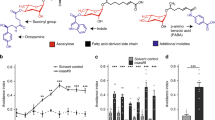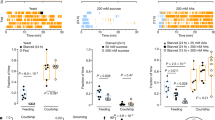Abstract
Wild isolates of Caenorhabditis elegans can feed either alone or in groups1,2. This natural variation in behaviour is associated with a single residue difference in NPR-1, a predicted G-protein-coupled neuropeptide receptor related to Neuropeptide Y receptors2. Here we show that the NPR-1 isoform associated with solitary feeding acts in neurons exposed to the body fluid to inhibit social feeding. Furthermore, suppressing the activity of these neurons, called AQR, PQR and URX, using an activated K+ channel, inhibits social feeding. NPR-1 activity in AQR, PQR and URX neurons seems to suppress social feeding by antagonizing signalling through a cyclic GMP-gated ion channel encoded by tax-2 and tax-4. We show that mutations in tax-2 or tax-4 disrupt social feeding, and that tax-4 is required in several neurons for social feeding, including one or more of AQR, PQR and URX. The AQR, PQR and URX neurons are unusual in C. elegans because they are directly exposed to the pseudocoelomic body fluid3. Our data suggest a model in which these neurons integrate antagonistic signals to control the choice between social and solitary feeding behaviour.
This is a preview of subscription content, access via your institution
Access options
Subscribe to this journal
Receive 51 print issues and online access
$199.00 per year
only $3.90 per issue
Buy this article
- Purchase on Springer Link
- Instant access to full article PDF
Prices may be subject to local taxes which are calculated during checkout




Similar content being viewed by others
References
Hodgkin, J. & Doniach, T. Natural variation and copulatory plug formation in Caenorhabditis elegans. Genetics 146, 149–164 (1997)
de Bono, M. & Bargmann, C. I. Natural variation in a neuropeptide Y receptor homolog modifies social behavior and food response in C. elegans. Cell 94, 679–689 (1998)
White, J. G., Southgate, E., Thomson, J. N. & Brenner, S. The structure of the nervous system of the nematode Caenorhabditis elegans. Phil. Trans. R Soc. Lond. B 314, 1–340 (1986)
Wang, Q. & Wadsworth, W. G. The C domain of NETRIN UNC-6 silences calcium/calmodulin-dependent protein kinase- and diacylglycerol-dependent axon branching in Caenorhabditis elegans. J. Neurosci. 22, 2274–2282 (2002)
Sengupta, P., Chou, J. H. & Bargmann, C. I. odr-10 encodes a seven transmembrane domain olfactory receptor required for responses to the odorant diacetyl. Cell 84, 899–909 (1996)
Dwyer, N. D., Troemel, E. R., Sengupta, P. & Bargmann, C. I. Odorant receptor localization to olfactory cilia is mediated by ODR-4, a novel membrane-associated protein. Cell 93, 455–466 (1998)
Stringham, E. G., Dixon, D. K., Jones, D. & Candido, E. P. Temporal and spatial expression patterns of the small heat shock (hsp16) genes in transgenic Caenorhabditis elegans. Mol. Biol. Cell 3, 221–233 (1992)
Yu, S., Avery, L., Baude, E. & Garbers, D. L. Guanylyl cyclase expression in specific sensory neurons: a new family of chemosensory receptors. Proc. Natl Acad. Sci. USA 94, 3384–3387 (1997)
Weinshenker, D., Wei, A., Salkoff, L. & Thomas, J. H. Block of an ether-a-go-go-like K+ channel by imipramine rescues egl-2 excitation defects in Caenorhabditis elegans. J. Neurosci. 19, 9831–9840 (1999)
Mori, I. Genetics of chemotaxis and thermotaxis in the nematode Caenorhabditis elegans. Annu. Rev. Genet. 33, 399–422 (1999)
Finn, J. T., Grunwald, M. E. & Yau, K. W. Cyclic nucleotide-gated ion channels: an extended family with diverse functions. Annu. Rev. Physiol. 58, 395–426 (1996)
Coburn, C. M. & Bargmann, C. I. A putative cyclic nucleotide-gated channel is required for sensory development and function in C. elegans. Neuron 17, 695–706 (1996)
Komatsu, H. et al. Functional reconstitution of a heteromeric cyclic nucleotide-gated channel of Caenorhabditis elegans in cultured cells. Brain Res. 821, 160–168 (1999)
Komatsu, H., Mori, I., Rhee, J. S., Akaike, N. & Ohshima, Y. Mutations in a cyclic nucleotide-gated channel lead to abnormal thermosensation and chemosensation in C. elegans. Neuron 17, 707–718 (1996)
Osborne, K. A. et al. Natural behavior polymorphism due to a cGMP-dependent protein kinase of Drosophila. Science 277, 834–836 (1997)
Ben-Shahar, Y., Robichon, A., Sokolowski, M. B. & Robinson, G. E. Influence of gene action across different time scales on behavior. Science 296, 741–744 (2002)
Marsh, D. J., Baraban, S. C., Hollopeter, G. & Palmiter, R. D. Role of the Y5 neuropeptide Y receptor in limbic seizures. Proc. Natl Acad. Sci. USA 96, 13518–13523 (1999)
Cowley, M. A. et al. Leptin activates anorexigenic POMC neurons through a neural network in the arcuate nucleus. Nature 411, 480–484 (2001)
Lee, D. L. & Atkinson, H. J. Physiology of Nematodes (Macmillan, London, 1976)
Li, C., Nelson, L., Kyuhyung, K., Nathoo, A. & Hart, A. C. Neuropeptide gene families in the nematode Caenorhabditis elegans. Ann. NY Acad. Sci. 897, 239–252 (1999)
Schwartz, M. W., Woods, S. C., Porte, D. Jr, Seeley, R. J. & Baskin, D. G. Central nervous system control of food intake. Nature 404, 661–671 (2000)
Robinson, G. E., Fahrbach, S. E. & Winston, M. L. Insect societies and the molecular biology of social behavior. Bioessays 19, 1099–1108 (1997)
Giraldeau, L.-A. & Caraco, T. Social Foraging Theory (Princeton Univ. Press, Princeton, New Jersey, 2000)
Sulston, J. & Hodgkin, J. The Nematode Caenorhabditis elegans (ed. Wood, W. B.) 587–606 (Cold Spring Harbor Laboratory, Cold Spring Harbor, 1988)
Clark, S. G., Lu, X. & Horvitz, H. R. The Caenorhabditis elegans locus lin-15, a negative regulator of a tyrosine kinase signaling pathway, encodes two different proteins. Genetics 137, 987–997 (1994)
Mello, C. C., Kramer, J. M., Stinchcomb, D. & Ambros, V. Efficient gene transfer in C. elegans: extrachromosomal maintenance and integration of transforming sequences. EMBO J. 10, 3959–3970 (1991)
Walhout, A. J. et al. GATEWAY recombinational cloning: application to the cloning of large numbers of open reading frames or ORFeomes. Methods Enzymol. 328, 575–592 (2000)
Li, C., Kim, K. & Nelson, L. S. FMRFamide-related neuropeptide gene family in Caenorhabditis elegans. Brain Res. 848, 26–34 (1999)
Acknowledgements
We thank C. Bargmann, A. Fire, R. Horvitz, C. Li, I. Mori, A. Wei and S. Yu for sharing unpublished data, constructs and strains; T. Stiernagle and the Caenorhabditis Genetics Centre for strains; and G. Brown, N. Hopper, N. Tremain and C. Bargmann for suggestions. Some of this work was done while M.d.B. was in the laboratory of C. Bargmann. We are grateful to B. Amos and S. Reichelt for assistance with confocal microscopy.
Author information
Authors and Affiliations
Corresponding author
Ethics declarations
Competing interests
The authors declare that they have no competing financial interests.
Supplementary information
Rights and permissions
About this article
Cite this article
Coates, J., de Bono, M. Antagonistic pathways in neurons exposed to body fluid regulate social feeding in Caenorhabditis elegans. Nature 419, 925–929 (2002). https://doi.org/10.1038/nature01170
Received:
Accepted:
Issue Date:
DOI: https://doi.org/10.1038/nature01170
This article is cited by
-
Semantic representation of neural circuit knowledge in Caenorhabditis elegans
Brain Informatics (2023)
-
Dissection of a sensorimotor circuit underlying pathogen aversion in C. elegans
BMC Biology (2022)
-
The gut efflux pump MRP-1 exports oxidized glutathione as a danger signal that stimulates behavioral immunity and aversive learning
Communications Biology (2022)
-
Neuronal subclass-selective proteomic analysis in Caenorhabditis elegans
Scientific Reports (2020)
-
Inactivity periods and postural change speed can explain atypical postural change patterns of Caenorhabditis elegans mutants
BMC Bioinformatics (2017)
Comments
By submitting a comment you agree to abide by our Terms and Community Guidelines. If you find something abusive or that does not comply with our terms or guidelines please flag it as inappropriate.



